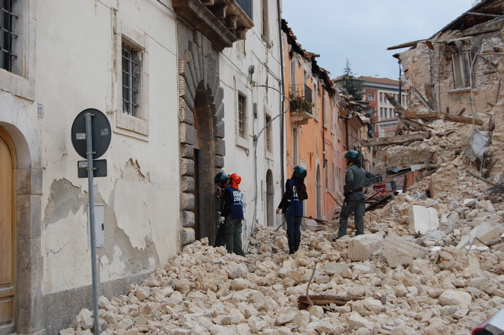

| Visitors Now: | |
| Total Visits: | |
| Total Stories: |

| Story Views | |
| Now: | |
| Last Hour: | |
| Last 24 Hours: | |
| Total: | |
Buildings Key To Beating Earthquakes
Wednesday, November 14, 2012 17:00
% of readers think this story is Fact. Add your two cents.
Strong buildings in earthquake zones are by the best form of defence against tremors, a university expert says.
Professor Iain Main, who was the sole UK member of a panel of scientists investigating the problem of earthquake forecasting following the L’Aquila quake of 2009, spoke following the recent conviction of six scientists in relation to the disaster.

Credit: Wikipedia
Professor Main said that it is possible to predict where an earthquake could occur, but impossible to predict their timing.
Most deaths are caused by falling masonry, and aiming to prevent this by making buildings as safe as possible in quake zones should be a priority, he adds.
We can’t predict earthquakes with any accuracy or reliability at present. No reliable precursors have been found, and we don’t expect any to emerge soon says Professor Main, School of GeoSciences
Scientists can forecast that earthquakes will almost certainly happen, but at a low background rate of once in 100 or 1,000 years, depending on the size of the quake and where it is.
This is used to assess the long term hazard, and set building design codes.
Before the L'Aquila quake, a series of small tremors - known as a seismic swarm - took place.
Such swarms are can temporarily raise the probability of a larger earthquake happening, but only to a low level, 1% or less.
In reality this could lead to a very high rate of false alarms - more than 99 per cent.
Local co-operation
Research is ongoing into how to quantify such probabilities accurately in real time.
Further studies are needed to identify the appropriate course of action, given such uncertain information, and how to communicate this in a way that respects local cultural context.
This requires interaction and co-operation between scientists, social scientists, local authorities, community groups and schools, and will need to be continuously tested.
Science-based disaster risk reduction is best conducted outside the highly-charged environment of a courtroom. There is no doubt its progress has been harmed by the court case and the judgement.
Contacts and sources:
Professor Iain Main, who was the sole UK member of a panel of scientists investigating the problem of earthquake forecasting following the L’Aquila quake of 2009, spoke following the recent conviction of six scientists in relation to the disaster.
Building damage from the L’Aquila quake

Credit: Wikipedia
Professor Main said that it is possible to predict where an earthquake could occur, but impossible to predict their timing.
Most deaths are caused by falling masonry, and aiming to prevent this by making buildings as safe as possible in quake zones should be a priority, he adds.
We can’t predict earthquakes with any accuracy or reliability at present. No reliable precursors have been found, and we don’t expect any to emerge soon says Professor Main, School of GeoSciences
Scientists can forecast that earthquakes will almost certainly happen, but at a low background rate of once in 100 or 1,000 years, depending on the size of the quake and where it is.
This is used to assess the long term hazard, and set building design codes.
Before the L'Aquila quake, a series of small tremors - known as a seismic swarm - took place.
Such swarms are can temporarily raise the probability of a larger earthquake happening, but only to a low level, 1% or less.
In reality this could lead to a very high rate of false alarms - more than 99 per cent.
Local co-operation
Research is ongoing into how to quantify such probabilities accurately in real time.
Further studies are needed to identify the appropriate course of action, given such uncertain information, and how to communicate this in a way that respects local cultural context.
This requires interaction and co-operation between scientists, social scientists, local authorities, community groups and schools, and will need to be continuously tested.
Science-based disaster risk reduction is best conducted outside the highly-charged environment of a courtroom. There is no doubt its progress has been harmed by the court case and the judgement.
Contacts and sources:


